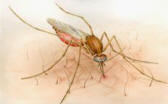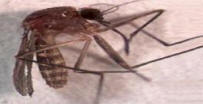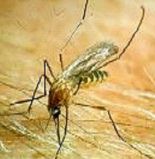
- Culex pipiens is a light brown, medium sized mosquito with a blunt tipped abdomen (body).
- There are narrow white bands on the body segments but none on the legs or proboscis (beak or biting mouth parts).
- Males resemble the females, but are easily recognized by their bushy antennae.
- House Mosquitoes have four life stages: egg, larva, pupa, and adult.
- After an adult female lays her eggs they hatch into larvae (wrigglers) which feed on small organic particles and micro-organisms in the water.
- About four to six days are required for larval development. At the end of the larval stage, the mosquito molts and becomes the aquatic pupa (tumbler).
- The pupa is active only if disturbed, for this is the resting stage where the larval form is transformed into the adult.
- This takes about two days during which time feeding does not occur. When the transformation is completed, the new adult splits the pupal skin and emerges.

- Wet Nile virus
- St Louis encephalitis
- Saint Louis Encephalitis:
- Fever, severe headache, nausea, and stiff neck.
- Severe cases may include vomiting, disorientation and paralysis.
- West Nile Virus:
- Fever, headache, nausea, body aches and swollen lymph nodes
- Where possible, sources of standing, fouling water should be eliminated by dumping, filling, pumping, or draining.
- Temporary containers around the home, such as buckets, flower vases, tubs, and tires should be checked
- Underground drains or cleanouts should also be checked.
- Eliminate unnecessary water holding containers, especially tires, large cans and bottles.
- Keep water clean in children's wading pool and drain when not in use.
- Keep ditches and streaming adjoining your property free of grass clippings, garbage, and other debris, which will obstruct the natural flow of the water.
- Keep weeds and grass cut short during the summer months. Report vacant lots that are not maintained properly to city or local officials.
- Make sure stored boats are covered or water drains out of them completely. Store small boats upside down.
- Change water in birdbaths, fountains and troughs weekly.
- Clean roof gutters.
- Make sure septic waste water does not lie on the ground surface and cesspools are sealed with screened vents.
